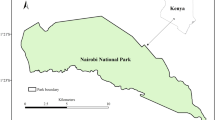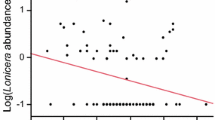Abstract
Whether invasion of introduced plant species may be aided by certain community properties is poorly understood for species-rich ecosystems, such as tropical montane forests. In Kenya, the non-native tree Fraxinus pennsylvanica has invaded degraded montane forests. We used generalized linear mixed models to examine the relative importance of different community properties to Fraxinus invasion after agricultural abandonment and in the secondary forest. Fraxinus invasion was positively related to plant community species diversity and the abundance of tree saplings, shrubs, ferns, and herbs in the abandoned fallows, but negatively related to the same community properties in the secondary forest. The number of Fraxinus recruits declined with declining propagule pressure in the fallows, but not in the secondary forest. Although adult and saplings of Fraxinus were positively related to community diversity in the fallows, Fraxinus appeared to decrease diversity in the secondary forest. These results show that the success of non-native species invasion and the effects of an invader on the resident community may depend both on properties and degree of disturbance of the community. Plant community diversity and evenness appeared to determine the invasion success by increasing invasibility of the abandoned fallows, but decreasing invasibility of the secondary forest. Our results from a tropical degraded forest emphasize the importance of including habitat characteristics when predicting both the potential of non-native plant invasion and effects of invasives on the particular community.

Similar content being viewed by others
References
Belote RT, Jones RH, Hood SM, Wender BW (2008) Diversity–invasibility across an experimental disturbance gradient in Appalachian forests. Ecology 89:183–192
Brown RL, Peet RK (2003) Diversity and invasibility of southern Appalachian plant communities. Ecology 84:32–39
Bruno JF, Stachowicz JJ, Bertness MD (2003) Inclusion of facilitation into ecological theory. Trends Ecol Evol 18:119–125
Burke MJ, Grime WJP (1996) An experimental study of plant community invasibility. Ecology 77:776–790
Chytry M, Jarosik V, Pyšek P, Hajek O, Knollova I, Danihelka J (2008) Separating habitat invasibility by alien plants from the actual level of invasion. Ecology 89:1541–1553
Colautti RI, Grigorovich IA, Macisaac HJ (2006) Propagule pressure: a null model for biological invasions. Bio Invasions 8:1023–1037
Davis MA (2003) Biotic globalization: does competition from introduced species threaten biodiversity. Bioscience 53:481–489
Dawson W, Mndolwa AS, Burslem DFRP, Hulme PE (2008) Assessing the risks of plant invasions arising from collections in tropical botanical gardens. Biodivers Conserv 17:1979–1995
Didham RK, Tylianakis JM, Hutchison MA, Ewers RM, Gemmel NJ (2005) Are invasive species the drivers of ecological change? Trends Eco Evol 20:470–474
Ditham RK, Tylianakis JM, Gemmel NJ, Rand TA, Ewers RM (2007) Interactive effects of habitat modification and species invasion on native species decline. Trends Ecol Evol 22:489–496
Dunstan PK, Johnson CR (2006) Linking richness, community variability and invasion resistance with patch size. Ecology 87:2842–2850
Edward E, Munishi PKT, Hulme PE (2008) Relative roles of disturbance and propagule pressure on the invasion of humid tropical forestry by Cordia alliodora (Boraginaceae) in Tanzania. Biotropica 41:171–178
Elton CS (1958) The ecology of invasion by animal and plants. Wiley, London
Friday JB, Scowcroft PG, Ares A (2008) Responses of native and invasive plant species to selective logging in an Acacia koa-Metrosideros polymorpha forest in Hawaii. Appl Veg Sci 11:471–482
Fridley JD, Vandermast DB, Kuppinger DM, Manthey M, Peet RK (2007) The invasion paradox: reconciling pattern and process in species invasions. Ecology 88:3–17
Ghersa CM, De La Fuente E, Suarez S, Leon RJC (2002) Woody species invasion in the Rolling Pampa grasslands, Argentina. Agric Ecosyst Environ 88:271–278
Gilbert B, Lechowizc MJ (2005) Invasibility and abiotic gradients: the positive correlation between native and exotics plant diversity. Ecology 86:1848–1855
Gorchov DL, Trisel DE (2003) Competitive effects of the invasive shrub, Lonicera mackkii (Rupr.) Herder (Caprifoliaceae), on the growth and survival of native tree seedlings. Plant Ecol 166:13–24
Gracia-robledo CA, Murcia C (2005) Comparative habitat susceptibility to invasion by Chinese ash (Fraxinus chinese: Oleaceae) in a tropical Andean landscape. Biol Invasions 7:405–415
Green PT, Lake PS, O’Dowd DJ (2004) Resistance of island rainforest to invasion by alien plants: influence of microhabitat and herbivory on seedling performance. Biol Invasions 6:1–9
Groninger JW, Baer SG, Bassana DA, Allen DH (2004) Planted green ash (Fraxinus pennsylvanica Marsh.) and herbaceous vegetation response to initial composition control during the first 3 years of afforestation. For Ecol Manag 189:161–170
Gurevitch J, Padilla DK (2004) Are invasive species a major cause of extinctions? TREE 19:470–474
Hector A, Dobson K, Minns A, Bazeley-White E, Lawton JH (2001) Community diversity and invasion resistance: an experimental test in a grassland ecosystem and a review of comparable studies. Ecol Res 16:819–831
Hejda M, Pyšek P (2006) What is the impact of Impatiens glandulifera on species diversity of invaded riparian vegetation? Biol Conserv 132:143–152
Hejda M, Pysek P, Jarosik V (2009) Impact of invasive plants on the species richness, diversity and composition of invaded communities. J Ecol 97:393–403
Hobbs RJ, Huenneke LF (1992) Disturbance, diversity and invasion: implication for conservation. Conserv Biol 6:324–337
Hooper DU, Chapin FS III, Ewel JJ, Hector A, Inchausti P, Lavorel S, Lawt JH, Lodge M, Loreau DM, Naeem S, Schmid B, Setälä H, Symstad AJ, Vandermeer J, Wardle DA (2005) Effects of biodiversity on ecosystem functioning: a consensus of current knowledge. Ecol Monogr 75:3–35
Hulme PE, Bremner ET (2006) Assessing the impact of Impatiens glandulifera on riparian habitats: partitioning diversity components following species removal. J Appl Ecol 43:43–50
Jackson AJH, Mccarter PS (1994) A profile of Mau forest complex. KEFCON, Nairobi
Kinyanjui JM (2009) The effect of human encroachment on forest cover, structure and composition in western blocks of Mau forest, Kenya. Ph.D. Dissertation, Egerton University, Njoro, Kenya
Kremer D, Cavlovic J, Bozic M (2006) Growth characteristics of introduced green ash (Fraxinus pennsylvanica marshall) and narrow-leaved ash (F-Angustifolia L.) in lowland forest region in Croatia. New Forests 31:211–224
Levine JM, D'Antonio CM (1999) Elton revisited: a review of evidence linking diversity and invasibility. Oikos 87:15–26
Levine JM, Vila M, D'Antonio CM, Dukes JS, Grigulis K, Lavorel S (2003) Mechanisms underlying the impacts of exotic plant invasions. Proc Royal Soc Biol Sci 270:775–781
Lesica P (2009) Can regeneration of green ash (Fraxinus pennsylvanica) be restored in declining woodlands in Eastern Montana? Rangel Ecol & Manag 62:564–571
Lonsdale WM (1999) Global patterns of plant invasions and the concept of invasibility. Ecology 80:1522–1536
Lugo AE (2004) The outcome of alien tree invasions in Puerto Rico. Front Ecol Environ 2:265–273
Mack MC, D’Antonio CM (1998) Impacts of biological invasions on disturbance regimes. Trends Ecol Evol 13:195–198
Martin PH, Canham CD, Marks PL (2009) Why forests appear resistant to exotic plant invasions: intentional introductions stand dynamics and the role of shade tolerance. Front Ecol Environ 7:142–149
Mattingly BW, Hewlate R, Reynolds HL (2007) Species evenness and invasion resistance of experimental grassland communities. Oikos 116:361–1170
Maundu P, Tengnas B (2005) Useful trees and shrubs for Kenya. Technical handbook No. 35. World Agroforestry Centre, Nairobi, Kenya
Milbau A, Nijs I (2004) The role of species traits (invasiveness) and ecosystem characteristics (invasibility) in grassland invasions: a framework. Weed Technol 18:1301–1304
Moira CW, Glenda MW (2005) The invasion of two Eucalypt forests by Pinus radiata in the Blue Mountains, New South Wales, Australia. Biol Conserv 125:56–64
Nunez MA, Pauchard A (2010) Biological invasions in developing and developed countries: does one model fit all? Biol Invasions 12:707–714
Ortega YK, Pearson DE (2005) Weak vs. strong invaders of natural plant communities: assessing invasibilty and impact. Ecol Appl 15:651–661
Pielou EC (1975) Ecological diversity. Wiley, New York
Pugnaire FI, Armas C, Valladares F (2004) Soils as mediator in plant–plant interactions in a semi-arid community. J Veg Sci 15:85–92
Pyšek P, Pyšek A (1995) Invasion by Heracleum mantegazziuanum in different habitats in the Czech Republic. J Veg Sci 6:711–718
R Development Core Team (2009) R: a language and environment for statistical computing. R Foundation for Statistical Computing, Vienna. http://www.R-Project.org
Rejmanek M, Richardson DM (1996) What attributes make some plant species more invasive? Ecology 77:1655–1661
Richardson DM (1998) Forestry trees as invasive aliens. Conserv Biol 12:18–26
Shea K, Chesson P (2002) Community ecology theory as a framework for biological invasions. Trends Ecol Evol 17:170–176
Standish RJ, Robertson AW, Williams PA (2001) The impact of an invasive weed Trdescantia fluminensis on native forest regeneration. J Appl Ecol 38:1253–1263
Totland Ø, Nyeko P, Bjerknes AL, Hegland SJ, Nielsen A (2005) Does forest gap size affect population size, plant size, reproductive success and pollinator visitation in Lantana camara, a tropical invasive shrub? For Ecol Manag 215:329–338
Vila M, Weiner J (2004) Are invasive species better competitions than native plant species? Evidence from pair-wise experiments. Oikos 105:229–238
Walck JL, Baskin JM, Baskin CC (1999) Effects of competition from introduced plants on establishment, survival, growth and reproduction of rare plant Solidago shortii (Asteraceae). Biol Conserv 88:213–219
Yurkonis KA, Meiners SJ (2004) Invasion impacts local species turnover in a successional system. Ecol Lett 7:63–769
Yurkonis KA, Meiners SJ, Wachholder BE (2005) Invasion impacts diversity through altered community dynamics. J Ecol 93:1053–1061
Zavaleta ES, Hulvey KB (2007) Realistic variation is species composition affects grassland production, resource use and invasion resistance. Plant Ecol 188:39–51
Acknowledgments
This study was supported by the European Union through the project ‘Bridging restoration and multi-functionality in degraded forest landscape of Eastern Africa and Indian Ocean Islands’ (FOREAIM). The first author is grateful to the Norwegian State Educational Loan Fund (Lånekassen) for providing financial assistance. We would like to thank farmers for information, Boaz Ngonga, William Bii and the late Florence Muindi, for their help in data collection, Solve Sæbø for assisting with GLMM analysis, Kenya Forestry Research Institute, Londiani, and Kenya Forest Service Itare stations for logistical support.
Author information
Authors and Affiliations
Corresponding author
Rights and permissions
About this article
Cite this article
Mullah, C.J.A., Klanderud, K., Totland, Ø. et al. Community invasibility and invasion by non-native Fraxinus pennsylvanica trees in a degraded tropical forest. Biol Invasions 16, 2747–2755 (2014). https://doi.org/10.1007/s10530-014-0701-6
Received:
Accepted:
Published:
Issue Date:
DOI: https://doi.org/10.1007/s10530-014-0701-6




